Numerical Prediction of Erosion of Francis Turbine in Sediment-Laden Flow under Different Heads
Abstract
:1. Introduction
2. Numerical Simulation Setup
2.1. Mathematical Model
2.1.1. Governing Equations
2.1.2. Particle Tracking Model
2.1.3. Erosion Model
2.2. Geometric Model Set-up
2.3. Parameter Setting in Calculation Model
2.4. Calculation Scheme
3. Numerical Simulation Reliability Verification
4. Analysis of Calculation Results
4.1. Flow Pattern in the Unit
4.2. Sediment Erosion at the Guide Vane and Stay Vane
4.3. Runner Blade Area
4.4. Velocity Distribution at Runner
5. Conclusions
Author Contributions
Funding
Data Availability Statement
Conflicts of Interest
References
- Ansari, B.; Aligholami, M.; Khosroshahi, A.R. An experimental and numerical investigation into using hydropower plant on oil transmission lines. Energy Sci. Eng. 2022, 10, 4397–4410. [Google Scholar] [CrossRef]
- Takaffoli, M.; Papini, M. Numerical simulation of solid particle impacts on Al6061-T6 part I: Three-dimensional representation of angular particles. Sediment Eros. 2012, 292, 100–110. [Google Scholar] [CrossRef]
- Song, X.; Liu, C. Zhengwei Wang. Prediction on the pressure pulsation induced by the free surface vortex based on experi-mental investigation and Biot-Saval Law. Ocean Eng. 2022, 250, 110934. [Google Scholar] [CrossRef]
- Song, X.; Luo, Y.; Wang, Z. Numerical prediction of the influence of free surface vortex air-entrainment on pump unit per-formance. Ocean Enging. 2022, 256, 111503. [Google Scholar] [CrossRef]
- Cheng, X.; Dong, F.; Yang, C. The influence of particle diameter on friction loss intensity and collision sediment erosion loss intensity along blades of centrifugal pump. J. Lanzhou Univ. Technol. 2015, 41, 44. [Google Scholar]
- Song, X.; Liu, C. Experimental investigation of floor-attached vortex effects on the pressure pulsation at the bottom of the axial flow pump sump. Renew. Energy 2019, 145, 2327–2336. [Google Scholar] [CrossRef]
- Matsumura, T.; Shirakashi, T.; Usui, E. Identification of Sediment erosion Characteristics in Tool Sediment erosion Model of Cutting Process. Int. J. Mater. Form. 2008, 1, 555–558. [Google Scholar] [CrossRef]
- Koirala, R.; Thapa, B.; Neopane, H.P.; Zhu, B. A review on flow and sediment erosion in guide vanes of Francis turbines. Renew. Sustain. Energy Rev. 2017, 75, 1054–1065. [Google Scholar] [CrossRef]
- Thapa, B.S.; Dahlhaug, O.G.; Thapa, B. Sediment erosion in hydro turbines and its effect on the flow aroundguide vanes of Francis turbine. Renev. Sustain. Energy Rev. 2015, 49, 1100–1113. [Google Scholar] [CrossRef]
- Nicolet, C.; Ruchonnet, N.; Avellan, F. One-dimensional modeling of rotor stator interaction in Francispump-turbine. In Proceedings of the 23rd IAHR Symposium on Hydraulic Machinery and Systems, Yokohama, Japan, 17–21 October 2006. [Google Scholar]
- Thapa, B.S.; Dahlhaug, G.; Thapa, B. Sediment erosion induced leakage flow from guide vane clearancegap in a low specific speed Francis turbine. Renew. Energy 2017, 107, 253–261. [Google Scholar] [CrossRef]
- Koirala, R.; Zhu, B.S.; Neopane, H.P. Effect of Guide Vane Clearance Gap on Francis Turbine Performance. Energies 2016, 9, 275. [Google Scholar] [CrossRef]
- Qian, Z.; Gao, Y.; Zhang, K.; Huai, W.; Wu, Y. Influence of dynamic seals on silt erosion of the impeller ring in a centrifugal pump. Proc. Inst. Mech. Eng. Part A J. Power Energy 2013, 227, 557–566. [Google Scholar] [CrossRef]
- Zhang, Y.; Qian, Z.; Ji, B.; Wu, Y. A review of microscopic interactions between cavitation bubbles and particles in silt-laden flow. Renew. Sustain. Energy Rev. 2016, 56, 303–318. [Google Scholar] [CrossRef]
- Smirnov, P.E. Sensitization of the SST turbulence model to rotation and curvature by applying the Spalart–Shur correction term. J. Turbomach. 2009, 131, 1407–1419. [Google Scholar] [CrossRef]
- Guo, B.; Xiao, Y.; Rai, A.K.; Zhang, J.; Liang, Q. Sediment-laden flow and erosion modeling in a Pelton turbine injector. Renew. Energy 2020, 162, 30–42. [Google Scholar] [CrossRef]
- Menter, F.R. Two-equation eddy-viscosity turbulence models for engineering applications. AIAA J. 1994, 32, 1598–1605. [Google Scholar] [CrossRef]
- Shrestha, U.; Chen, Z.; Park, S.H.; Choi, Y.D. Numerical studies on sediment erosion due to sediment characteristics in Francis hydro turbine. IOP Conf. Ser. Earth Environ. Sci. 2019, 240, 042001. [Google Scholar] [CrossRef]
- Shen, Z.; Chu, W.; Li, X.; Dong, W. Sediment erosion in the impeller of a double-suction centrifugal pump—A case study of the Jingtai Yellow River Irrigation Project, China. Sediment Eros. 2019, 422–423, 269–279. [Google Scholar] [CrossRef]
- Gautam, S.; Neopane, H.P.; Thapa, B.S.; Chitrakar, S.; Zhu, B. Numerical Investigation of the Effects of Leakage Flow from Guide Vanes of Francis Turbines using Alternative Clearance Gap Method. J. Appl. Fluid Mech. 2020, 13, 1407–1419. [Google Scholar]
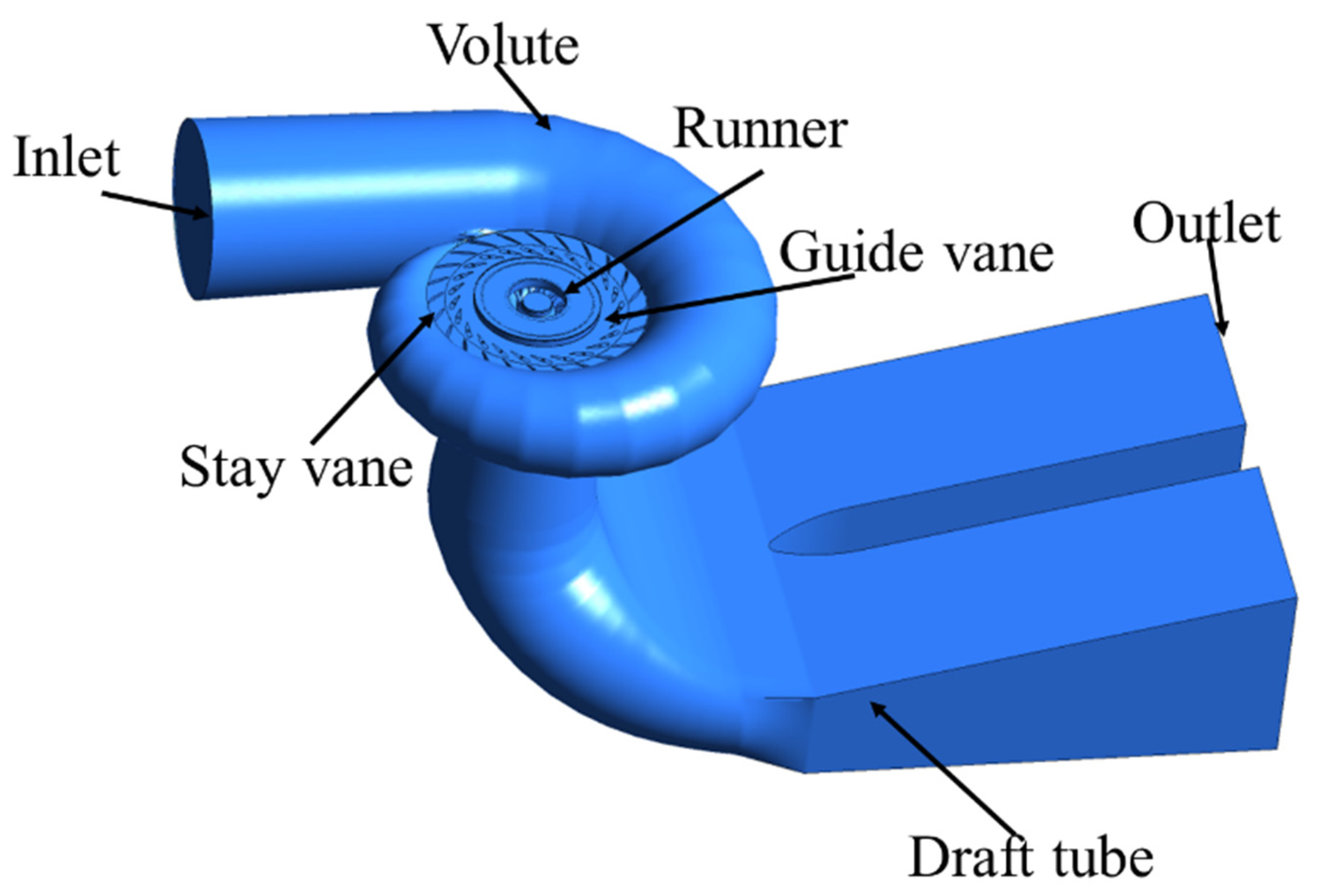
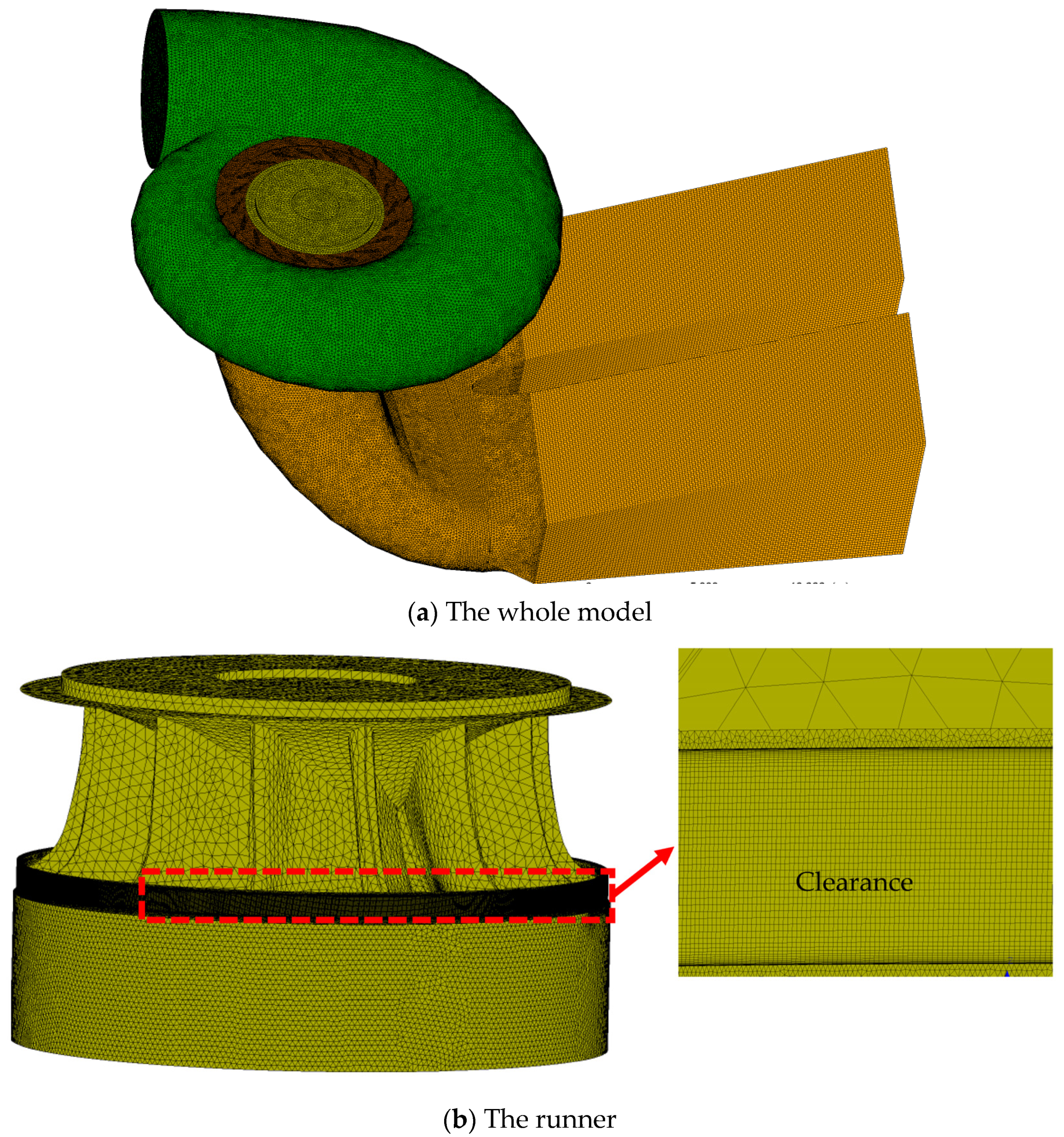
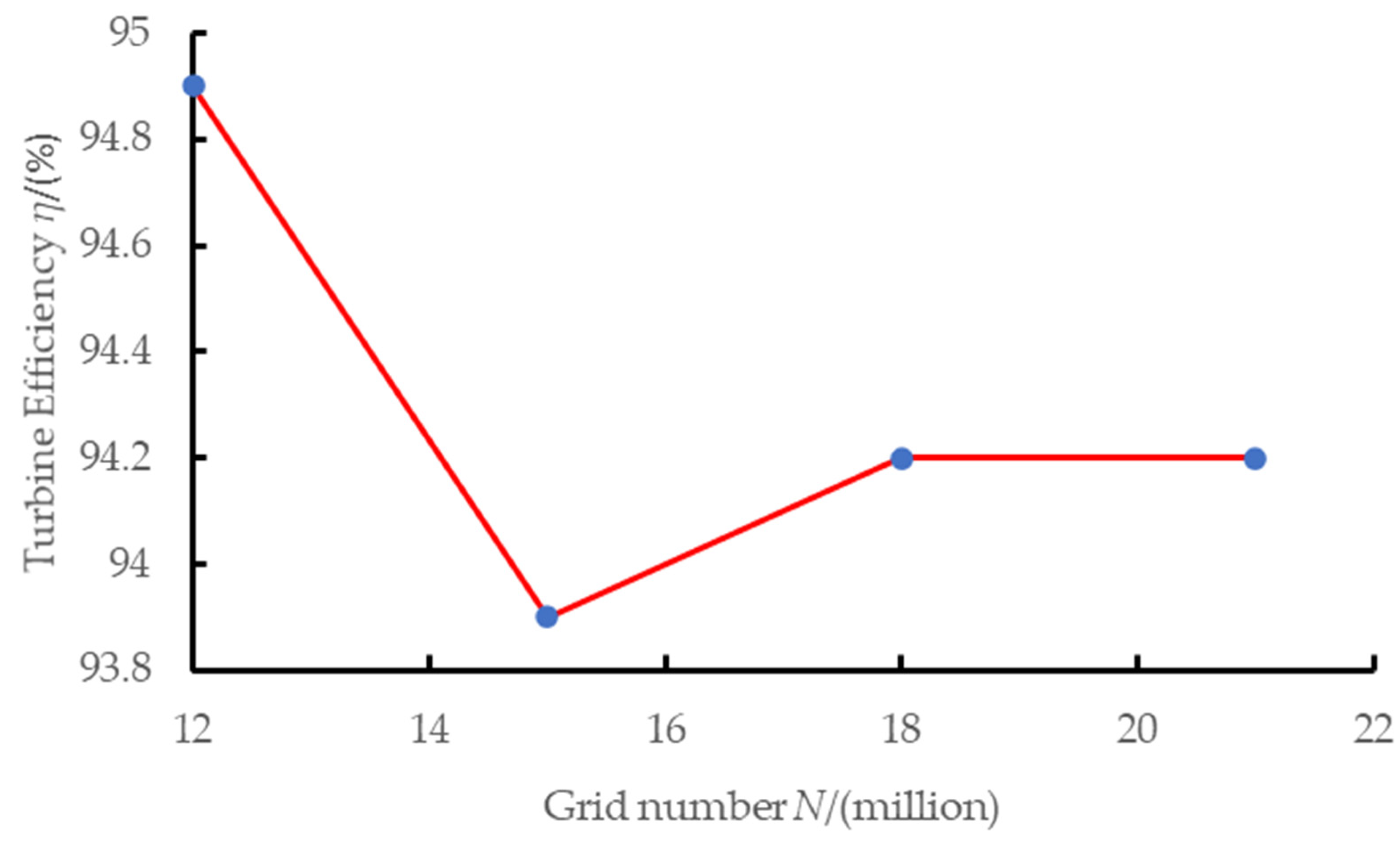
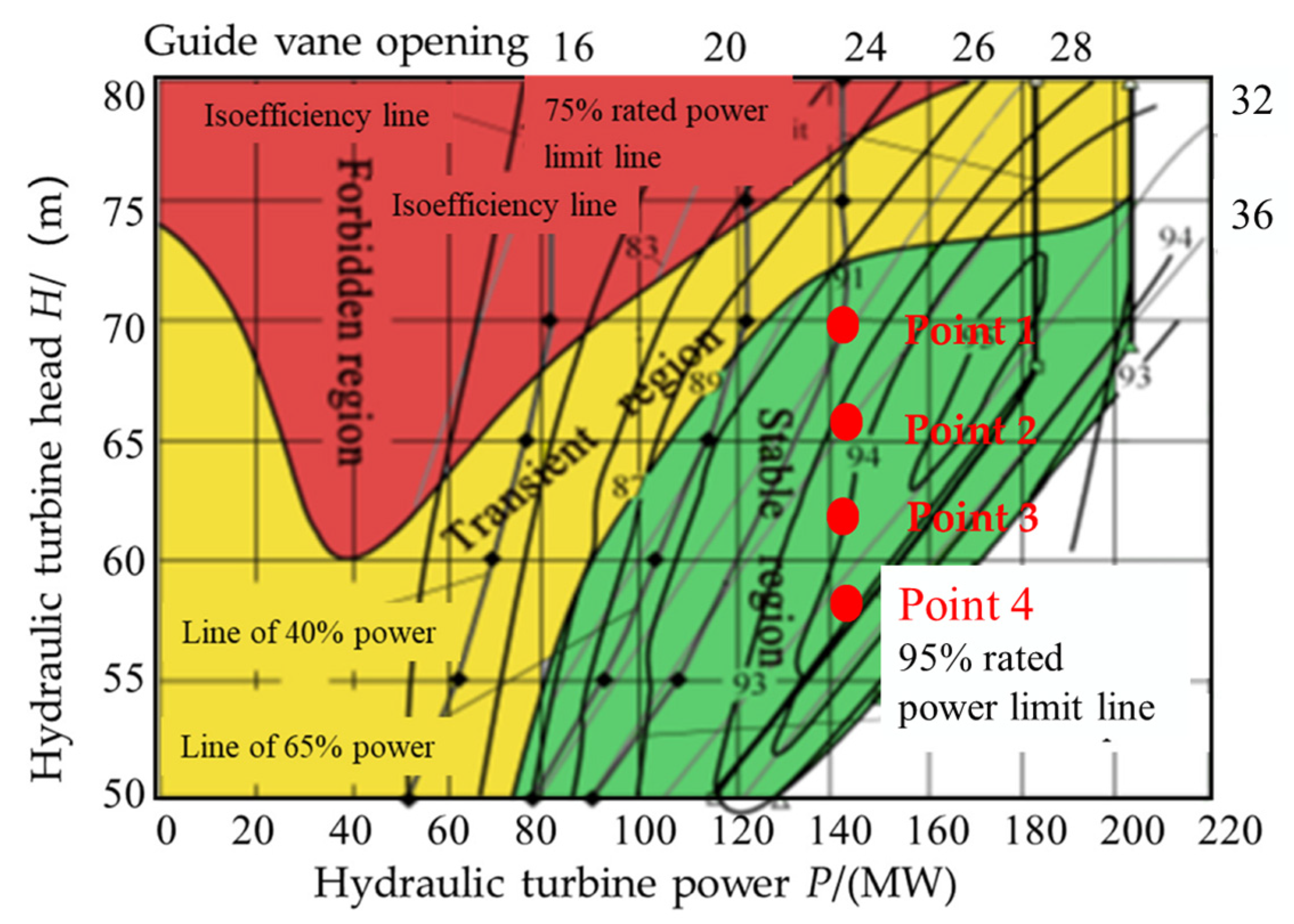
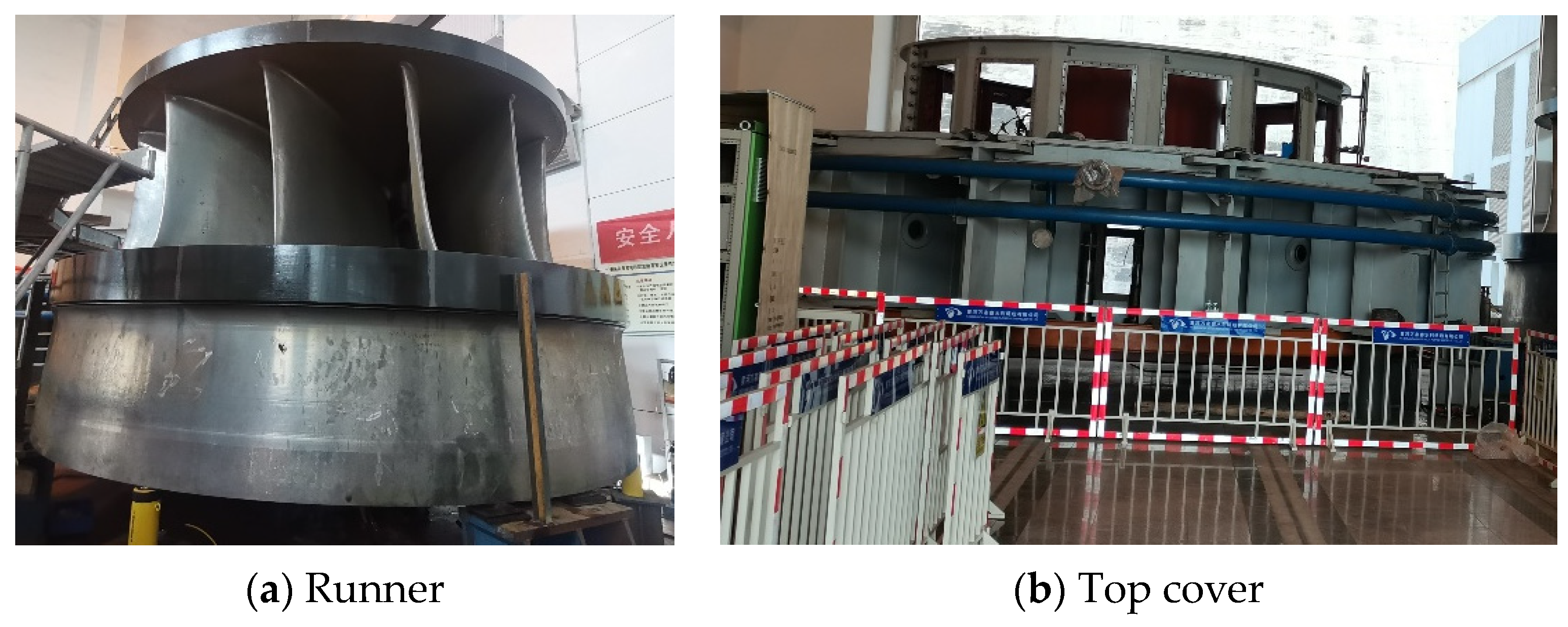
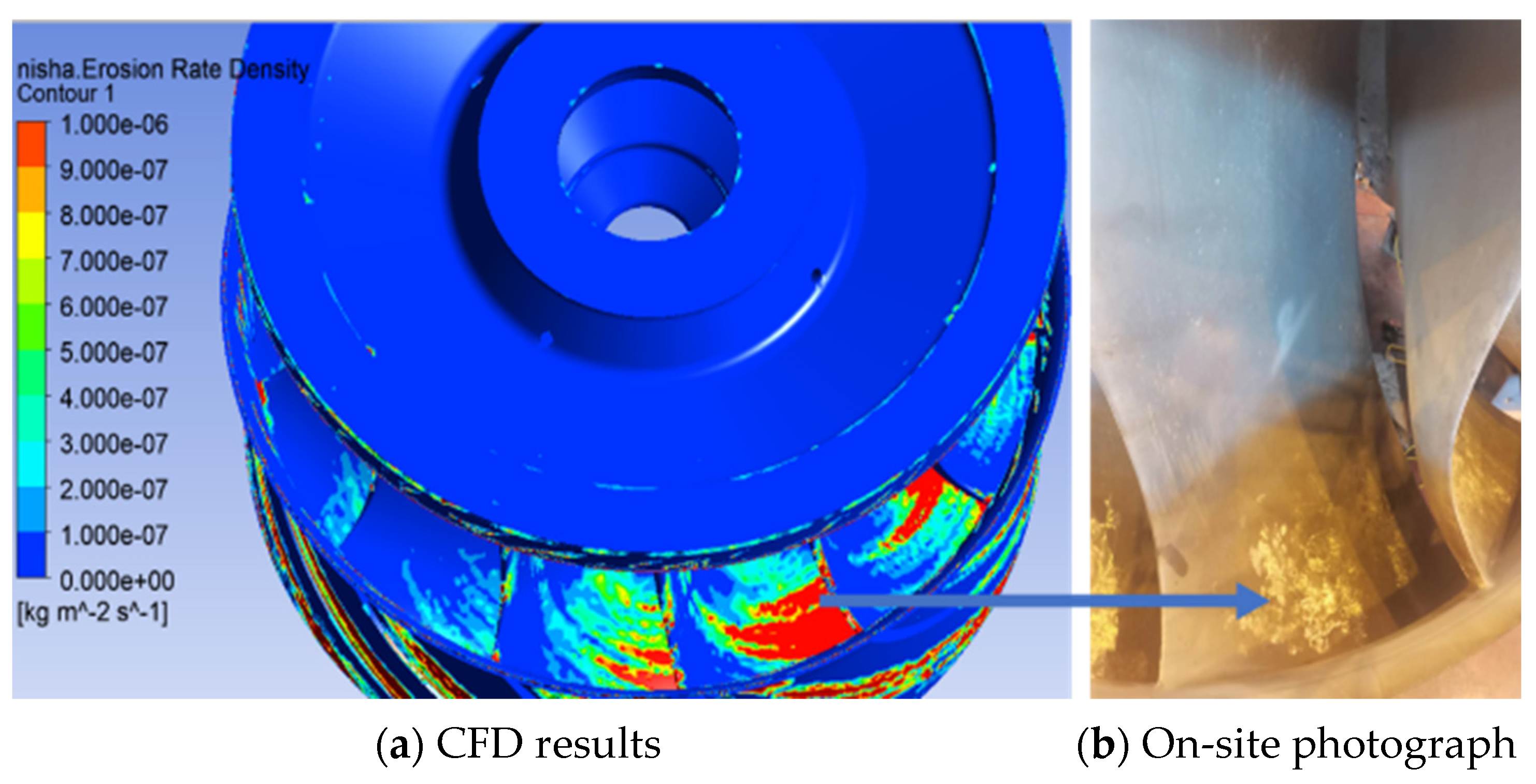
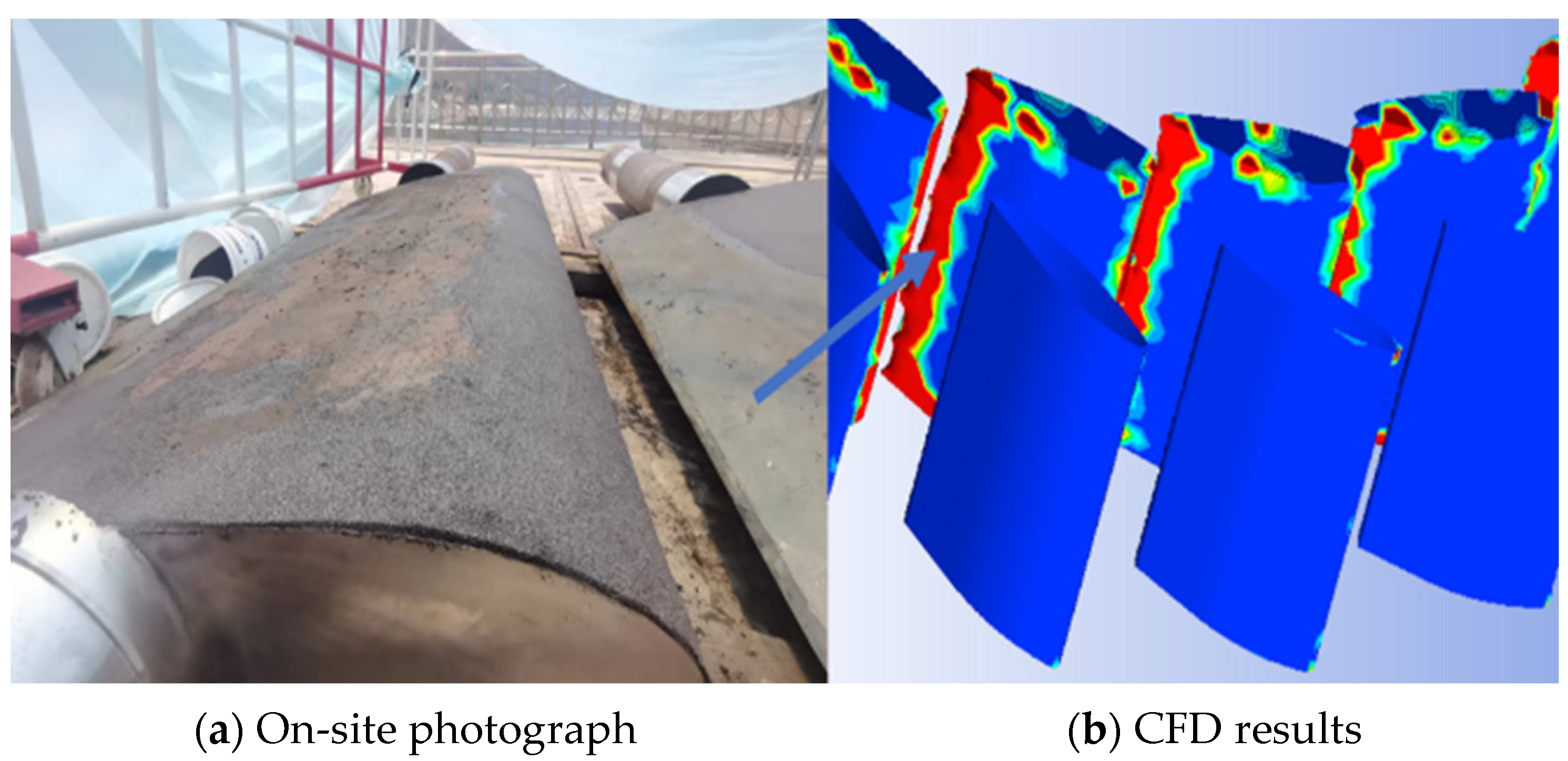


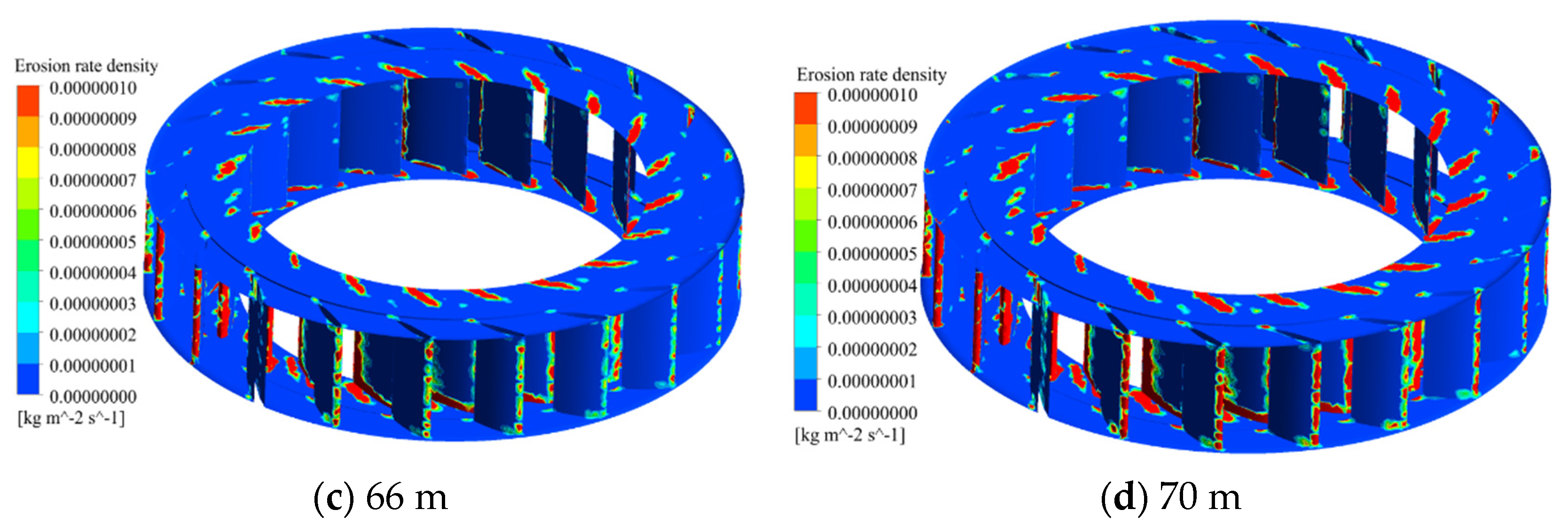

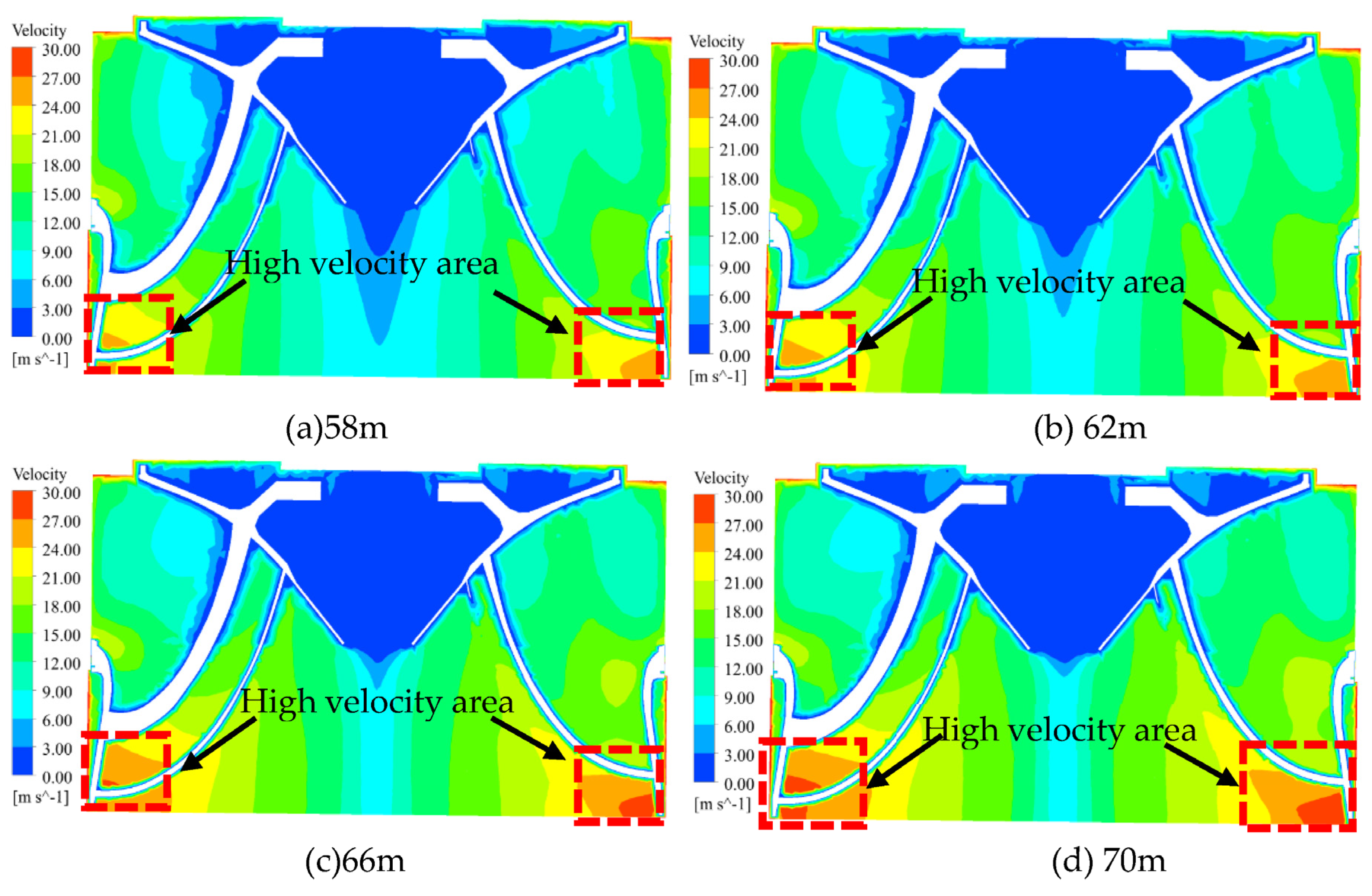
| Point | CFD Efficiency | Experimental Efficiency | n11 | Q11 |
|---|---|---|---|---|
| Point 1 | 94.05% | 94.51% | 77.85 | 0.7864 |
| Point 2 | 94.72% | 94.32% | 78.55 | 0.3678 |
| Point 3 | 94.25% | 94.24% | 91.21 | 0.3495 |
Disclaimer/Publisher’s Note: The statements, opinions and data contained in all publications are solely those of the individual author(s) and contributor(s) and not of MDPI and/or the editor(s). MDPI and/or the editor(s) disclaim responsibility for any injury to people or property resulting from any ideas, methods, instructions or products referred to in the content. |
© 2023 by the authors. Licensee MDPI, Basel, Switzerland. This article is an open access article distributed under the terms and conditions of the Creative Commons Attribution (CC BY) license (https://creativecommons.org/licenses/by/4.0/).
Share and Cite
Wang, J.; Song, X.; Wang, H.; Tao, R.; Wang, Z. Numerical Prediction of Erosion of Francis Turbine in Sediment-Laden Flow under Different Heads. Processes 2023, 11, 2523. https://doi.org/10.3390/pr11092523
Wang J, Song X, Wang H, Tao R, Wang Z. Numerical Prediction of Erosion of Francis Turbine in Sediment-Laden Flow under Different Heads. Processes. 2023; 11(9):2523. https://doi.org/10.3390/pr11092523
Chicago/Turabian StyleWang, Jinliang, Xijie Song, Hu Wang, Ran Tao, and Zhengwei Wang. 2023. "Numerical Prediction of Erosion of Francis Turbine in Sediment-Laden Flow under Different Heads" Processes 11, no. 9: 2523. https://doi.org/10.3390/pr11092523
APA StyleWang, J., Song, X., Wang, H., Tao, R., & Wang, Z. (2023). Numerical Prediction of Erosion of Francis Turbine in Sediment-Laden Flow under Different Heads. Processes, 11(9), 2523. https://doi.org/10.3390/pr11092523










